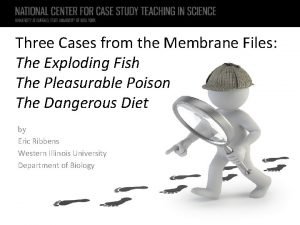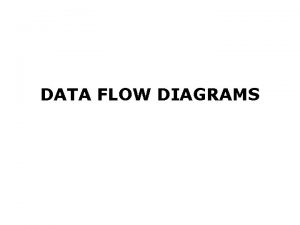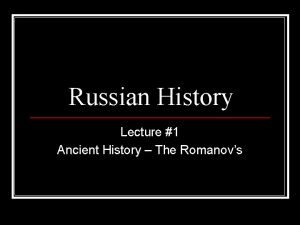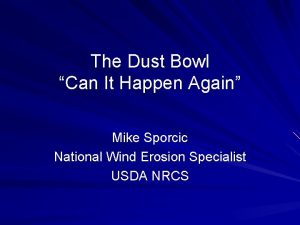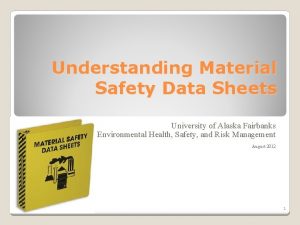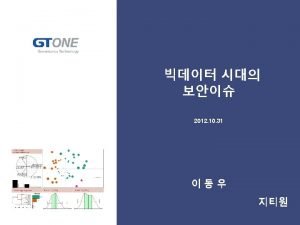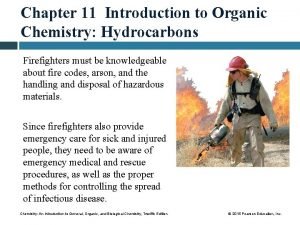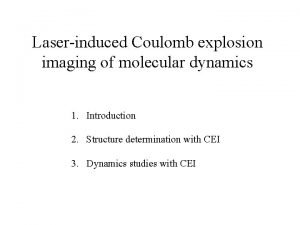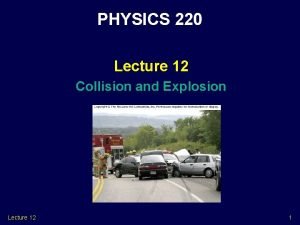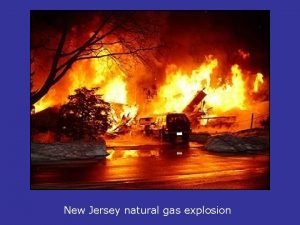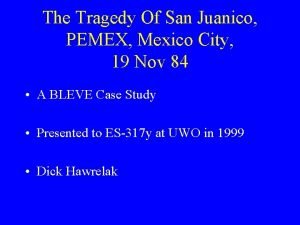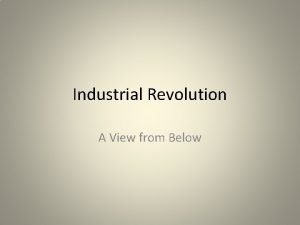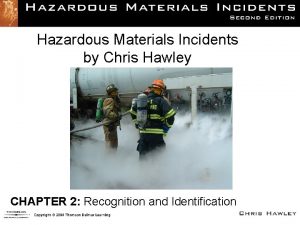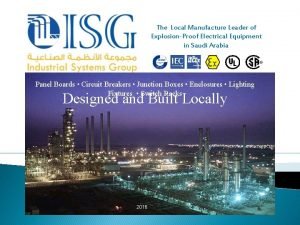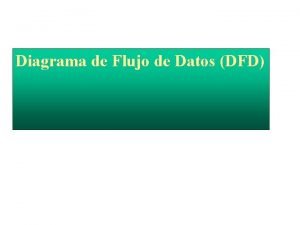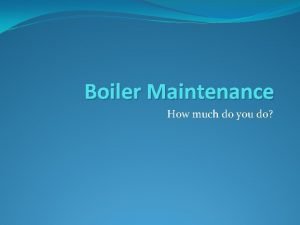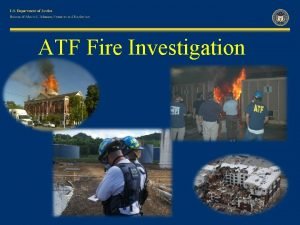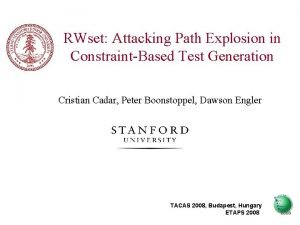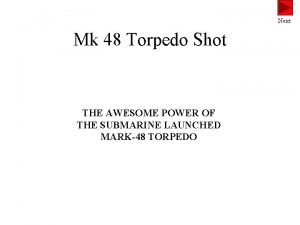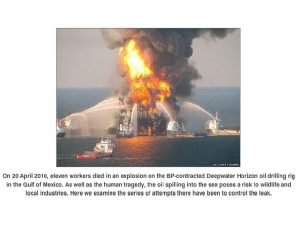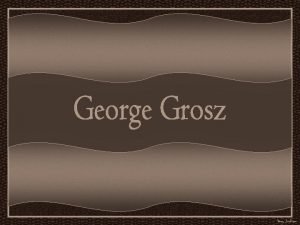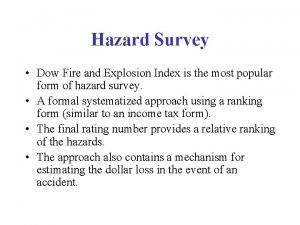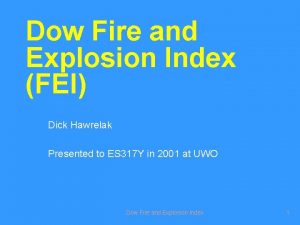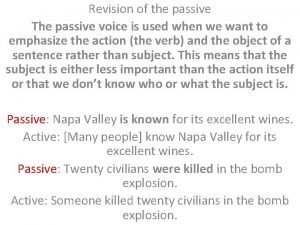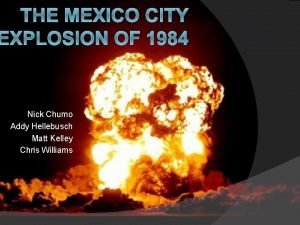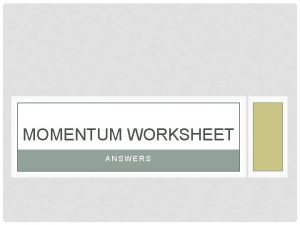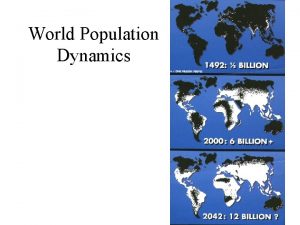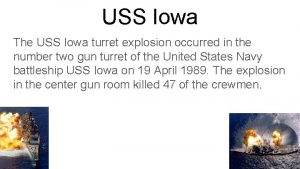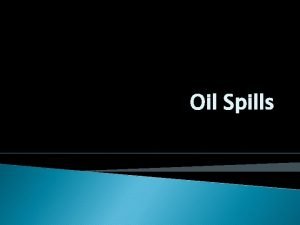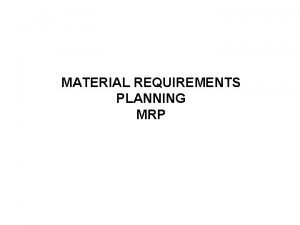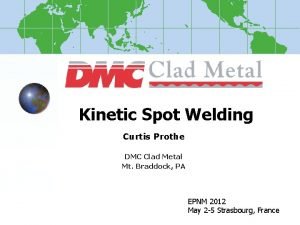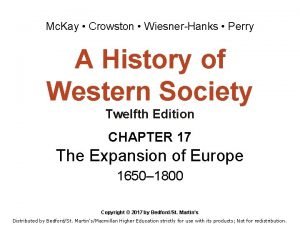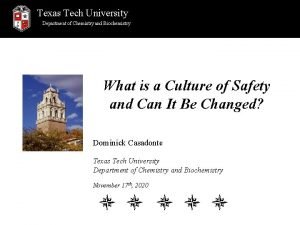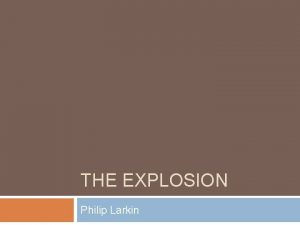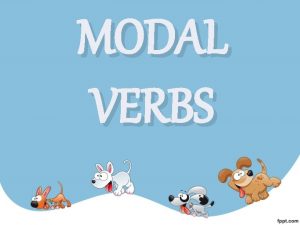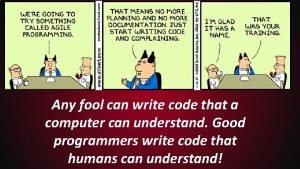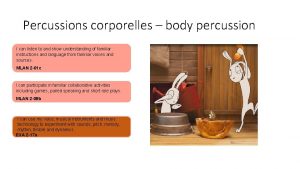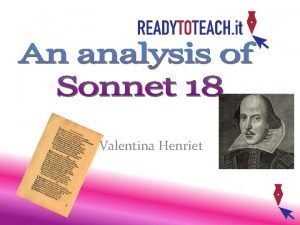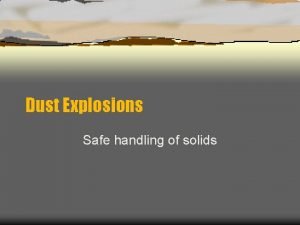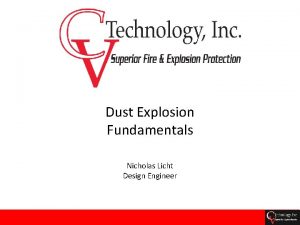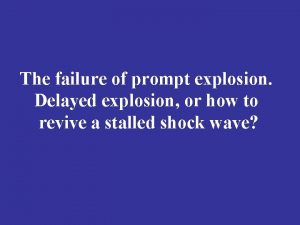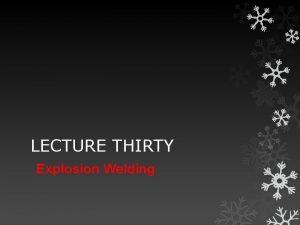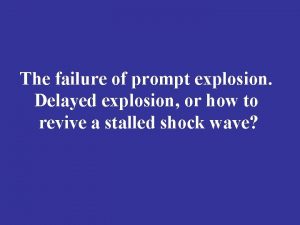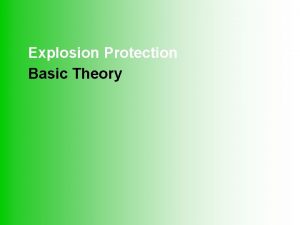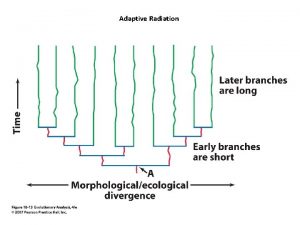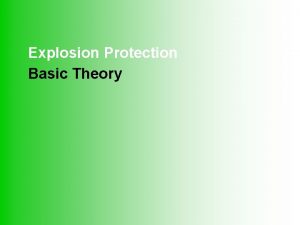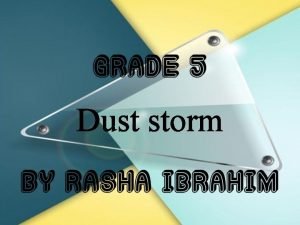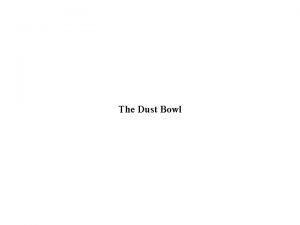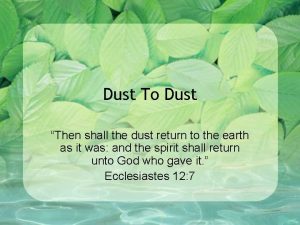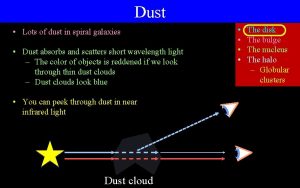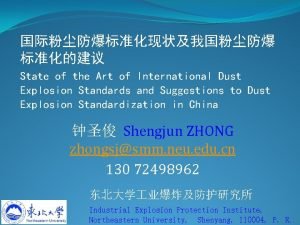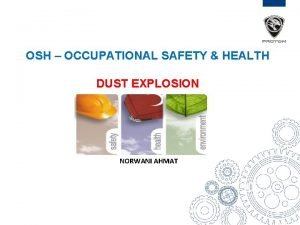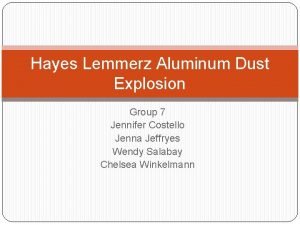Dust Explosion Fundamentals Dust can explode 1 Dust






















![Ignition Source MIE values of some dusts Material MIE with inductance [m. J] MIE Ignition Source MIE values of some dusts Material MIE with inductance [m. J] MIE](https://slidetodoc.com/presentation_image_h/bb314d66d04fbfa772153c6f3cca4316/image-23.jpg)
![Ignition Source Ignition of titanium dust Size MIE [m. J] Without inductance MIT [°C] Ignition Source Ignition of titanium dust Size MIE [m. J] Without inductance MIT [°C]](https://slidetodoc.com/presentation_image_h/bb314d66d04fbfa772153c6f3cca4316/image-24.jpg)




![Oxidant LOC values of some dusts Material LOC with nitrogen [volume %] Pea flour Oxidant LOC values of some dusts Material LOC with nitrogen [volume %] Pea flour](https://slidetodoc.com/presentation_image_h/bb314d66d04fbfa772153c6f3cca4316/image-29.jpg)
![Oxidant Inert gas effectiveness Magnesium Dust Inert Gas LOC [volume %] Nitrogen (diatomic) 6. Oxidant Inert gas effectiveness Magnesium Dust Inert Gas LOC [volume %] Nitrogen (diatomic) 6.](https://slidetodoc.com/presentation_image_h/bb314d66d04fbfa772153c6f3cca4316/image-30.jpg)







































- Slides: 69

Dust Explosion Fundamentals Dust can explode! 1

Dust Explosion Fundamentals Fire triangle and explosion pentagon NI TI O N DAN T FU N OXIDANT OXI ING MIX O ITI N IG EL L E FU IG CONFINEMENT 2

Dust Explosion Fundamentals Hammermill – pentagon in practice 3

Dust Explosion Fundamentals How dusts explode n Chemical explosion n Propagating combustion reaction n Reaction mechanism n Dust/air mixture heterogeneous; reaction may be heterogeneous (few) or homogenous (most) n Most dusts explode as gas explosions n Volatiles from solid material n Explosion: FUEL (dust) and OXIDANT are MIXED, ignited by IGNITION SOURCE, and sufficient CONFINEMENT results in overpressure development 4

Dust Explosion Fundamentals How coal dust explodes 5

Dust Explosion Fundamentals Dust explosion parameters n Laboratory-scale testing can determine dust explosion parameters for hazard/risk determination n Likelihood of occurrence n n MEC: Minimum Explosible Concentration MIE: Minimum Ignition Energy MIT: Minimum Ignition Temperature LOC: Limiting Oxygen Concentration n Severity of consequences n n n Pmax: Maximum explosion pressure (d. P/dt)max: Maximum rate of pressure rise KSt = (d. P/dt)max · V 1/3 6

Dust Explosion Fundamentals Testing standards and equipment n ASTM E 1226 -12 a: Standard Test Method for Explosibility of Dust Clouds n ASTM E 1515 -07: Standard Test Method for Minimum Explosible Concentration of Combustible Dusts n ASTM E 2019 -03 (2013): Standard Test Method for Minimum Ignition Energy of a Dust Cloud in Air n ASTM E 1491 -06 (2012): Standard Test Method for Minimum Autoignition Temperature of Dust Clouds 20 -L Apparatus MIKE 3 Apparatus 7 BAM Oven

Dust Explosion Fundamentals Risk control standards n NFPA 61 – Agriculture and Food Industries n NFPA 68 – Deflagration Venting n NFPA 69 – Prevention Systems n NFPA 120 – Coal Mines n NFPA 484 – Combustible Metals n NFPA 499 – Electrical Installations n NFPA 654 – Manufacturing, Processing and Handling Dusts n NFPA 664 – Wood Processing 8

Basic Fire Principles Confinement Dust Layer Fires Fuel Dust Explosion Fundamentals Case Studies Prevention and Mitigation Ignition Source Resources Oxidant Evaluation Element 1 of 5 – Fuel F TI ING MIX FUEL ON DAN T L E U IG NI OXI Mixing Basic Explosion Principles CONFINEMENT 9

Fuel Dust and combustible dust n NFPA definition of dust n Any finely divided solid, 500 µm or less in diameter n NFPA definition of combustible dust n A combustible particulate solid that presents a fire or deflagration hazard when suspended in air or some other oxidizing medium over a range of concentrations, regardless of particle size or shape. 10

Fuel Examples of combustible dusts n Coal and coal products n Food products n Metals and alloys n Rubber and plastics n Wood products n Textiles n Pharmaceuticals n Pesticides De. Bruce Grain Elevator Explosion 11

Fuel Examples of process units n Silos n Hoppers n Dust collectors n Grinders n Dryers n Furnaces n Mixers n Pulverizing units n Conveying systems Bucket Elevator 12

Fuel How much layered dust is too much? Sugar dust accumulation on steel belt drive motor Cornstarch accumulation under cornstarch silo 13

Fuel Calculation of dust concentration C = ρbulk (h/H) n C = dust concentration n ρbulk = bulk density of dust layer n h = thickness of dust layer n H = height of dust cloud produced from dust layer 14

Fuel Example: C = ρbulk (h/H) h = 1 mm ρbulk = 500 kg/m 3 H = 5 m C = 100 g/m 3 H = 1 m C = 500 g/m 3 15

Fuel Particle size n In general, as particle size of a given dust decreases, there is an increase in both explosion severity and likelihood n n Pmax increases KSt increases (potentially significantly) MEC, MIE and MIT all decrease Smaller particle → larger surface area → higher reactivity n For nanomaterials, testing to date indicates an increase in explosion likelihood but no significant increase in severity n Limited severity effect likely caused by particle agglomeration during dispersion 16

Fuel Particle shape n Non-spherical particles can be combustible n Flake-like particles n Flocculent particles (fibers with L/D ratio) Wood Fibers Nylon Flock 17

Fuel Both of these dusts are combustible Spherical Polyethylene Fibrous Polyethylene 18

Fuel Hybrid mixtures n Flammable gas and combustible dust n May each be present in concentrations less than their individual LFL (gas) and MEC (dust), and still be explosible n Result in increased explosion severity and likelihood n Examples Methane gas and coal dust n Natural gas and fly ash n Hydrocarbon gases and resins n 19

Basic Fire Principles Confinement Dust Layer Fires Fuel Dust Explosion Fundamentals Case Studies Prevention and Mitigation Ignition Source Resources Oxidant Evaluation Element 2 of 5 – Ignition Source TI ON ING MIX IGNITION SOURCE T F NI DAN L UE IG OXI Mixing Basic Explosion Principles CONFINEMENT 20

Ignition Source Examples of ignition sources n Flames and direct heat n Hot work n Incandescent materials n Hot surfaces n Electrostatic sparks n Electrical sparks n Friction sparks n Impact sparks n Self-heating n Static electricity n Lightning n Shock waves 21

Ignition Source MIE and MIT testing n MIE and MIT testing can be conducted to better identify potential ignition source hazards n MIE and MIT test results are applicable to efforts aimed at dust explosion prevention Removal of ignition sources n Grounding and bonding n Control of process/surface temperatures n 22
![Ignition Source MIE values of some dusts Material MIE with inductance m J MIE Ignition Source MIE values of some dusts Material MIE with inductance [m. J] MIE](https://slidetodoc.com/presentation_image_h/bb314d66d04fbfa772153c6f3cca4316/image-23.jpg)
Ignition Source MIE values of some dusts Material MIE with inductance [m. J] MIE without inductance [m. J] Epoxy coating powder 1. 7 2. 5 Polyester coating powder 2. 9 15 Polyamide coating powder 4 19 Magnesium granulate 25 200 Flock 69 -98 1300 -1600 23
![Ignition Source Ignition of titanium dust Size MIE m J Without inductance MIT C Ignition Source Ignition of titanium dust Size MIE [m. J] Without inductance MIT [°C]](https://slidetodoc.com/presentation_image_h/bb314d66d04fbfa772153c6f3cca4316/image-24.jpg)
Ignition Source Ignition of titanium dust Size MIE [m. J] Without inductance MIT [°C] <150 µm <45 µm ≤ 20 µm 10 -30 1 -3 <1 >590 460 150 nm 60 -80 nm 40 -60 nm Not determined <1 <1 <1 250 240 250 24

Ignition Source Destruction at 10 m. J ABS (Acrylonitrile-Butadiene-Styrene) Plant 25

Basic Fire Principles Confinement Dust Layer Fires Dust Explosion Fundamentals Fuel Case Studies Prevention and Mitigation Ignition Source Resources Oxidant Evaluation Element 3 of 5 – Oxidant F NI TI ON ING MIX OXIDANT DAN T L E U IG OXI Mixing Basic Explosion Principles CONFINEMENT 26

Oxidant Limiting oxygen concentration n Oxygen is the most common oxidant n Does not have to be completely removed to prevent a dust explosion n Limiting oxygen concentration (LOC) Highest oxygen concentration in a dust/air/inert gas mixture at which an explosion fails to occur n Value for a given dust depends on inert gas used n Industry application – inerting n 27

Oxidant Use of inert gas n Inert gas examples – carbon dioxide, nitrogen argon, helium, steam, flue gas n Inerting can introduce new hazards Asphyxiation from reduced oxygen levels in air n Reaction of inert gas with dust n Electrostatic discharge when CO 2 is drawn from high-pressure or cryogenic tanks n Leakage of inert gas in systems under pressure n Introduction of ignition sources from inerting equipment such as vacuum pumps n 28
![Oxidant LOC values of some dusts Material LOC with nitrogen volume Pea flour Oxidant LOC values of some dusts Material LOC with nitrogen [volume %] Pea flour](https://slidetodoc.com/presentation_image_h/bb314d66d04fbfa772153c6f3cca4316/image-29.jpg)
Oxidant LOC values of some dusts Material LOC with nitrogen [volume %] Pea flour 15. 5 Calcium stearate 12. 0 Wheat flour 11. 0 High-density polyethylene 10. 0 Sulfur 7. 0 Aluminum 5. 0 29
![Oxidant Inert gas effectiveness Magnesium Dust Inert Gas LOC volume Nitrogen diatomic 6 Oxidant Inert gas effectiveness Magnesium Dust Inert Gas LOC [volume %] Nitrogen (diatomic) 6.](https://slidetodoc.com/presentation_image_h/bb314d66d04fbfa772153c6f3cca4316/image-30.jpg)
Oxidant Inert gas effectiveness Magnesium Dust Inert Gas LOC [volume %] Nitrogen (diatomic) 6. 8 Carbon dioxide (triatomic) 5. 5 Argon (monatomic) 4. 0 30

Oxidant Effect on Pmax and (d. P/dt)max Brown Coal Dust/Air/Nitrogen 31

Oxidant Effect on MEC (nitrogen) 32

Basic Fire Principles Confinement Dust Layer Fires Dust Explosion Fundamentals Fuel Case Studies Prevention and Mitigation Ignition Source Resources Oxidant Evaluation Element 4 of 5 – Mixing NI ON DAN ING MIXING TI T EL U F IG OXI Mixing Basic Explosion Principles CONFINEMENT 33

Mixing Primary dust explosions 34

Mixing Secondary dust explosions 35

Mixing Primary/secondary dust explosions n Primary dust explosions generally occur inside process vessels and units n Mills, grinders, dryers, etc. n Secondary dust explosions are caused by dispersion of dust layers by an energetic disturbance n Upset conditions/poor housekeeping practices n n Vigorous sweeping; cleaning with compressed air Blast wave from primary explosion n Gas or dust explosion; other explosion types 36

Mixing Dustiness/dispersibility Characteristic Influence on Dispersion Particle size Larger diameter → higher settling velocity Particle specific surface area Larger specific surface area → lower settling rate Dust moisture content Higher moisture content → reduced dispersibility Dust density Higher density → higher settling velocity Particle shape Asymmetry and roughness → lower settling velocity Agglomeration processes Impact effective particle diameter 37

Mixing Turbulence n Some degree of turbulence will always exist in a dust cloud n No such thing as a quiescent dust cloud within the confines of the earth’s gravitational field n Effects of turbulence n Increased ignition requirements n n Highly turbulent dust clouds are harder to ignite Heightened combustion rates n Once ignited, highly turbulent dust clouds yield more severe consequences 38

Mixing Turbulence and overpressure 39

Mixing Turbulence and rate of pressure rise 40

Basic Fire Principles Confinement Dust Layer Fires Fuel Dust Explosion Fundamentals Case Studies Prevention and Mitigation Ignition Source Resources Oxidant Evaluation Element 5 of 5 – Confinement EL FU IG NI TI ON ING DAN MIX T CONFINEMENT OXI Mixing Basic Explosion Principles CONFINEMENT 41

Confinement Role of confinement n 42

Confinement Degree of confinement n No confinement/low confinement n Flash fire n Dust explosion rare occurrence n Partial confinement n Fireball with limited pressure rise and flame propagation n Explosion development possible n Complete confinement n Full overpressure development 43

Confinement Partial confinement Methane-triggered coal dust explosion with fireball emerging from mine portal Bruceton Experimental Mine Pittsburgh, PA 44

Confinement Partial confinement n Underground mine workings n Approximate mine gallery as a corridor with one end open, ignition occurring at opposite end n Explosion development and flame propagation follows corridor n Burned gases expand behind flame front and push unburned fuel/air mixture toward open end of corridor, generating turbulence n Flame front accelerates as it reaches turbulent flow field n Self-accelerating feedback mechanism 45

Confinement Congestion n Obstacles can create congestion (blockage) and generate significant post-ignition turbulence Boom Truck Westray 46

Confinement Influence of obstacle type 47

Confinement Explosion relief venting n Dust explosion mitigation n Overpressure is reduced by relieving confinement Corn Flour Explosion with Relief Venting 48

Basic Fire Principles Mixing Confinement Basic Explosion Principles Dust Layer Fires Dust Explosion Fundamentals Prevention and Mitigation Fuel Case Studies Ignition Source Resources Oxidant Evaluation Dust Layer Fires Magnesium Dust Layer Fire 49

Dust Layer Fires Ignition of dust layers n Self-heating (self-ignition) n External heat source n Pieces of metal n n Nut or bolt (heated by repeated contact with equipment surfaces) Overheated surface n Bearing or motor n Layer Ignition Temperature (LIT) n Minimum temperature required to ignite a layer of dust of a certain thickness 50

Dust Layer Fires Effect of layer thickness ALOM = Aluminum Oxide; CD = Coal Dust; LP = Lycopodium; BWD = Beechwood Dust 51

Dust Layer Fires Self-ignition 52

Dust Layer Fires Normalization of deviance n Dust fires are sometimes ignored or normalized Accepting as normal (and then ignoring) negative events n Culture of risk-denial n Counter to concept of safety culture n n Evidence that something is not right in the workplace n Nothing normal about an unintentional dust fire 53

Basic Fire Principles Mixing Confinement Basic Explosion Principles Dust Layer Fires Dust Explosion Fundamentals Prevention and Mitigation Fuel Case Studies Ignition Source Resources Oxidant Evaluation Prevention and Mitigation ALARP 54

Prevention and Mitigation Hierarchy of controls INHERENT SAFETY PASSIVE ENGINEERED SAFETY ACTIVE ENGINEERED SAFETY PROCEDURAL SAFETY 55

Prevention and Mitigation Hierarchy as a continuum 56

Prevention and Mitigation Inherent safety n Proactive approach to reduce reliance on engineered or add-on safety devices (both passive and active) and procedural measures n Four basic principles n Minimization n Substitution n Moderation n Simplification 57

Prevention and Mitigation Minimize amount of hazardous material in use (when use of such materials cannot be avoided – i. e. elimination) 58

Prevention and Mitigation Substitution Replace substance with less hazardous material; replace process route with one involving less hazardous materials 59

Prevention and Mitigation Moderation Use hazardous materials in least hazardous forms; run process equipment with less severe operating conditions 60

Prevention and Mitigation Simplification Simplify equipment and processes that are used; avoid complexities; make equipment robust; eliminate opportunities for error 61

Prevention and Mitigation Minimum inerting concentration 62

Prevention and Mitigation Passive engineered safety n Add-on safety devices n Explosion relief vents n Physical barriers n Have no function other than to act when called upon to mitigate consequences of an explosion n Do not require event detection or device activation n More reliable than active devices 63

Prevention and Mitigation Venting Corn Flour Explosion with Relief Venting 64

Prevention and Mitigation Venting process 65

Prevention and Mitigation Relief panels and rupture disks 66

Prevention and Mitigation Flameless venting Corn Flour Explosion with Flameless Venting 67

Prevention and Mitigation Flame quenching devices 68

Prevention and Mitigation Active engineered safety n Add-on safety devices n Inerting (gas) systems n Automatic explosion suppression n Explosion isolation valves n Have no function other than to act when called upon to mitigate consequences of an explosion n Require event detection and device activation n Less reliable than passive devices 69
 Saltwater fish in freshwater explode
Saltwater fish in freshwater explode Black hole data flow diagram
Black hole data flow diagram Soviets explode first atomic bomb
Soviets explode first atomic bomb Rider
Rider Can the dust bowl happen again
Can the dust bowl happen again Explosion hazard
Explosion hazard Share jesus without fear outline
Share jesus without fear outline Data explosion
Data explosion Pentane condensed structural formula
Pentane condensed structural formula Coulomb explosion
Coulomb explosion Heavy elements formed
Heavy elements formed A freight train is being assembled in a switching yard
A freight train is being assembled in a switching yard Halifax man butane explosion
Halifax man butane explosion Bleve san juanico
Bleve san juanico Population explosion industrial revolution
Population explosion industrial revolution Mass explosion hazard placard
Mass explosion hazard placard Sun explosion candy
Sun explosion candy Example of population explosion
Example of population explosion Conceivable in a sentence
Conceivable in a sentence Explosion proof electrical junction boxes
Explosion proof electrical junction boxes Diagrama de flujo de calcular el area de un triangulo
Diagrama de flujo de calcular el area de un triangulo Cleaver brooks boiler explosion
Cleaver brooks boiler explosion Hash oil explosion
Hash oil explosion Oil rig explosion
Oil rig explosion Path explosion
Path explosion Torpedo 48 shots
Torpedo 48 shots Explosion tredi hombourg
Explosion tredi hombourg Population explosion
Population explosion Oil rig explosion
Oil rig explosion Georg grosz explosion
Georg grosz explosion Spriggna
Spriggna Fire and explosion index
Fire and explosion index Evangelism explosion outline
Evangelism explosion outline Dow fei
Dow fei Population explosion
Population explosion Passive of i want someone to love me
Passive of i want someone to love me Mass explosion hazard sign
Mass explosion hazard sign Data explosion
Data explosion Nomogram harry king calculator
Nomogram harry king calculator Options diamond thinking routine
Options diamond thinking routine Cambrian explosion
Cambrian explosion Bleve mexico city 1984
Bleve mexico city 1984 Oil rig explosion
Oil rig explosion Population growth factors
Population growth factors Halifax explosion definition
Halifax explosion definition During a goal line stand a 75 kg
During a goal line stand a 75 kg Population explosion in india
Population explosion in india Population explosion refers to the-
Population explosion refers to the- Oil rig explosion
Oil rig explosion Iowa turret explosion
Iowa turret explosion Oil rig explosion
Oil rig explosion Mps vs mrp
Mps vs mrp Dmc explosion welding
Dmc explosion welding The population explosion
The population explosion Ttu chemistry department
Ttu chemistry department Philip larkin the explosion
Philip larkin the explosion Already can or can already
Already can or can already You can tell harris about it just ____(easily) as i can
You can tell harris about it just ____(easily) as i can Express ability and inability
Express ability and inability Going on a bear hunt with dr jean
Going on a bear hunt with dr jean If you cannot measure it you cannot manage it
If you cannot measure it you cannot manage it Kinds of comparison
Kinds of comparison Any fool can write code that a computer can understand
Any fool can write code that a computer can understand Comparative and superlative for less
Comparative and superlative for less Through you nothing is impossible
Through you nothing is impossible If you think you can you can poem
If you think you can you can poem Percussions corporelles
Percussions corporelles Metaphor in sonnet 18
Metaphor in sonnet 18 I cant but he can
I cant but he can If you can't measure it you cannot improve it
If you can't measure it you cannot improve it
